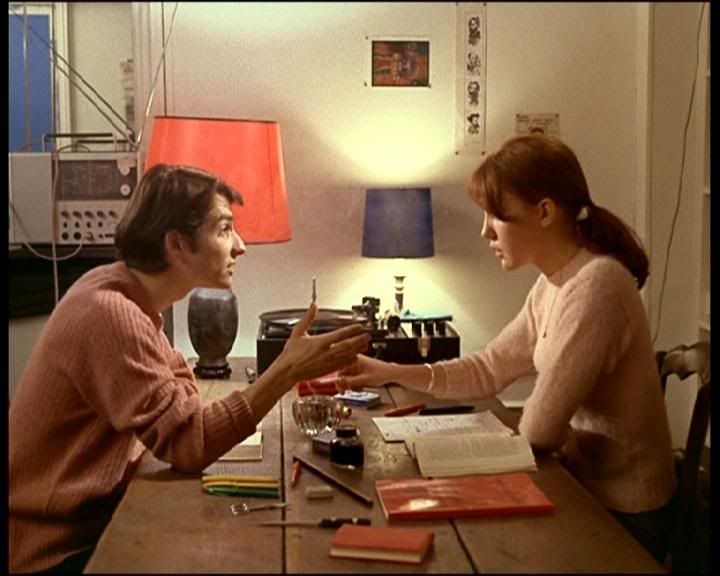
Godard's La Chinoise lies at the heart of his revolutionary period, and provides a powerful look at what was soon to come from this chameleonic director. By 1967, Godard had spent the previous 2 years increasingly moving into political filmmaking, largely eschewing the genre plots of earlier years and reducing characters down to abstractions and mouthpieces for ideas. Godard had never been content to work in any one mode, but his films prior to 1965 or so usually provided a way in for more casual viewers, whether it was the playful musical pastiche of A Woman is a Woman or the lighthearted stabs at noir in Band of Outsiders and Breathless. This was not the case by the time 1967 rolled around, and La Chinoise proves the point. In some ways, it is emblematic of the more difficult films Godard had made prior to that — complex use of on-screen texts, direct interviews to the actors, the exposure of the filmmaking artifice — but it also represents a new break in his work, pointing ahead to the apocalyptic Week-end, made later that year, and to the tract-like political films he'd make with the Dziga Vertov Group.
In La Chinoise, Godard fully embraced the complete political filmmaking style that he'd been hinting towards in earlier works like Masculin Féminin and Made in USA. The plot is minimal — a group of students spend a summer vacation at their parents' vacated apartment, discussing political theory and plotting revolution — and the characters are skeletal. The focus here is clearly not on story or characterization, but on ideas. These ideas are presented in a series of dialogues and monologues in which the students quote from Communist and anarchist tracts, argue about points of theory, and plan for a Maoist revolution in France. In these discussions, Godard employs a dialectical structure that's partly indigenous to socialism — with its emphasis on proletariat vs. bourgeosie, revolutionary vs. reactionary — and partly a product of Godard's own probing mind.
This is especially apparent in the film's best scene, an impassioned discussion between Veronique (Godard's then-wife Anne Wiazemsky) and the real-life French dissident Francis Jeanson, who was once imprisoned for aiding the Algerian independence movement. Veronique advocates violent revolt and terrorism, especially as directed against universities, while Jeanson questions the wisdom or efficacy of such measures in this context. His interesting argument is that in the Algerian context, the whole populace was united in the goal of independence, or at least sympathetic to it, so terrorism in that movement had a certain moral force and a chance to achieve something. He dismisses such violence in the French context, where there would be no such unity of purpose in the population with regards to a socialist revolution. This dialogue also points out the essential emptiness of the students' movement, as Veronique openly avows that she has no idea what to do next; she simply wants action and seems unwilling to examine the consequences or think about the future. Throughout this scene, Godard remains impassive, mostly filming the two from the side as they sit facing each other, so that their contrasting views have a kind of equivalence on the screen. It's up to the viewer to parse the arguments and decide which is correct, without any input from Godard.
It's ultimately this ambiguity that keeps La Chinoise from being just a political tract. Godard is concerned with violence, and change, and especially with the possibilities for action and new thinking among young people. But if he's especially concerned with the young in this phase of his career, he doesn't invest any blind hope in them either. Masculin Féminin ended with a rather harsh outlook on modern youth's moral weakness and lack of engagement. La Chinoise is somewhat more hopeful, stressing learning and education (though decidedly not traditional, university-based education) and the possibility that this nascent and confused movement may grow. Or, then again, maybe not.
It's always a wise move to follow up such a dense and complex movie with something a little frothier — if I ever try to watch more than one Godard film in a night, it tends to make my head hurt. So, in this spirit, I followed La Chinoise with Hitchcock's romantic farce To Catch a Thief. Somewhat uncharacteristically for Hitch, there isn't much suspense here, or even much humor — it's more amusing than actually funny — but there's plenty of charm to make up for it. This was a vacation picture for Hitch, a chance to film on the French Riviera and to let his favorite actors Cary Grant and Grace Kelly light up the screen. Well, Grant is looking a little worse for wear here, though his charm is intact, but Kelly completely steals the show and makes the film. More than anything, this is a tribute to her great beauty, a cinematic ode to a gorgeous woman. There's not much else there — a light caper, a minimal mystery, a frisson of romance, and some stunning color cinematography. The night scenes, bathed in gentle green light, are especially lovely, culminating in the wonderfully arranged climactic scene, the rooftop chase in which Grant attempts to corner the cat burglar whose crimes he was suspected of. And the film's most famous scene remains its best: the love scene into which Hitchcock cleverly cut images of the fireworks exploding outside. The editing here is a masterpiece of symbolic montage, as Hitch shows a long shot, then fireworks, then a slightly closer shot, then fireworks, then a closeup on the actors just inches apart. The editing reflects the increasing intimacy, and throughout the scene Grant and Kelly engage in witty banter with the kinds of light sexual undertones that Hitch loved so much. This scene alone makes the film worthwhile viewing, and there's lots more to love in the film's general charm and beauty. Not a masterpiece, but fun nonetheless.

No comments:
Post a Comment